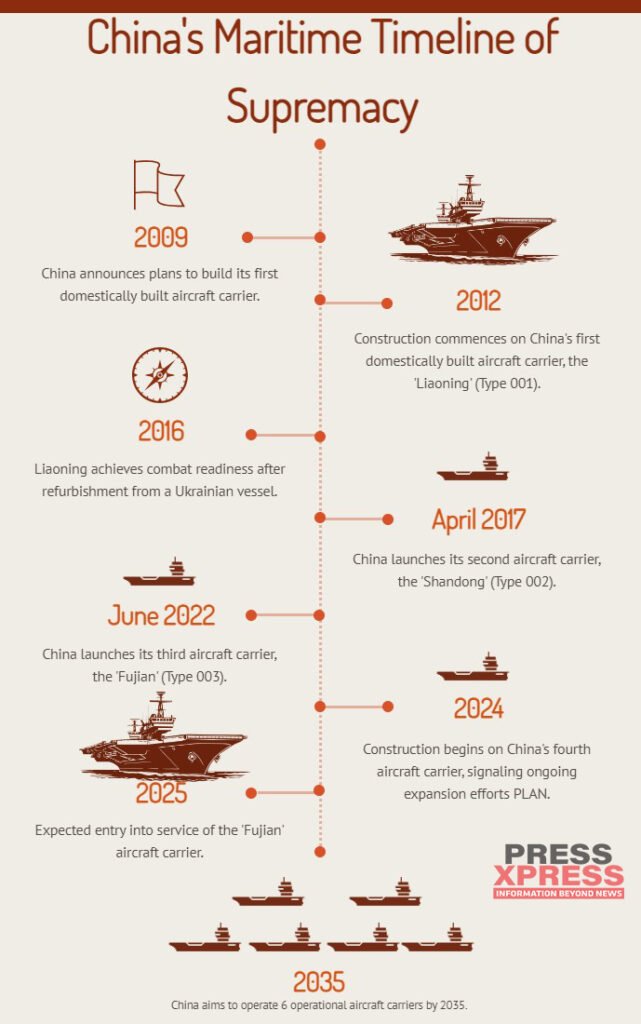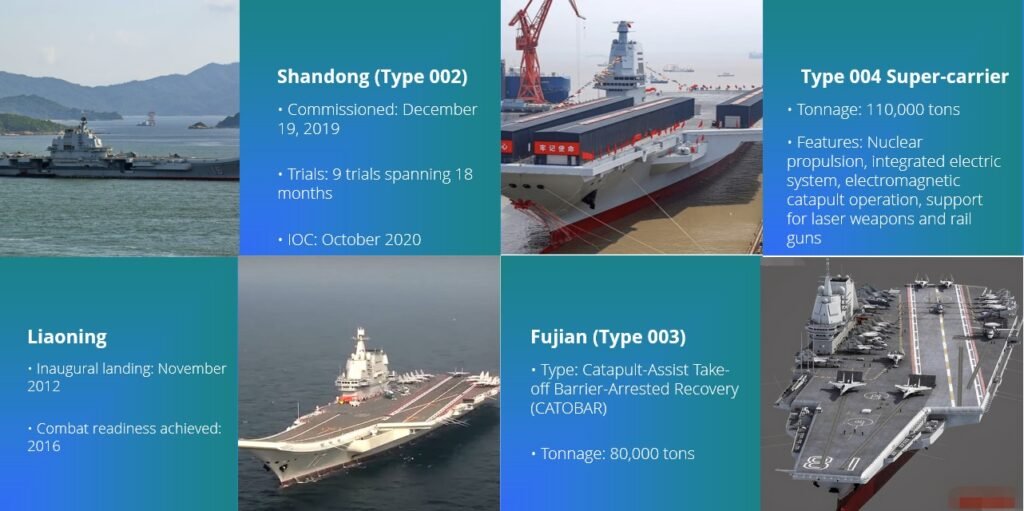Key Highlights:
- As the People’s Liberation Army Navy (PLAN) continues its significant expansion efforts, reports indicate that construction has commenced on the much-anticipated 4th Chinese aircraft carrier, boasting advanced capabilities
- In November 2012, Liaoning successfully executed its inaugural landing with the Shenyang J-15, albeit with reduced fuel for weight management
- The Indian Navy typically organizes its fleet with three carriers, each assigned to the crucial maritime areas: the Arabian Sea, Indian Ocean, and Bay of Bengal
In the present world military world order, from Beijing’s standpoint, the source of the security threat in the Pacific region lies in the fact that the Republic of China, as Taiwan officially calls itself, receives security guarantees from the US. Five US aircraft carriers are currently deployed to the Pacific region, according to US media reports.
German News Agency DW mentioned, “Chinese politicians are increasingly referring to “peace and security on both shores,” a phrase that many experts believe is no longer just about the Taiwan Strait, but refers to the Pacific Ocean as a whole.”
You Can Also Read: Do China’s Economic Resilience and Challenges Have Global Impact?
In fact, what are the real scenarios? Chinese ship developers are believed to have started testing electromagnetic catapults on China’s third aircraft carrier, which military analysts observe is a significant milestone in the country’s naval ship construction.
The catapults will be used for launching airplanes from the carrier, named Fujian after the Chinese province closest to Taiwan. The Fujian features a so-called Catapult Assisted Take-Off Barrier Arrested Recovery, or CATOBAR, system that is much more advanced than the first two carriers.
Co-relating this, we can see, that as the People’s Liberation Army Navy (PLAN) continues its significant expansion efforts, reports indicate that construction has commenced on the much-anticipated 4th Chinese aircraft carrier, boasting advanced capabilities. This development heralds a substantial enhancement to China’s maritime power, complementing the growing array of destroyers, frigates, conventional and nuclear submarines, and assault ships within its fleet.
Notably, the achievement is accentuated by the relatively short span of less than 9 years since the commissioning of China’s first aircraft carrier, the “Liaoning” (Type 001), which, refurbished from a Ukrainian vessel, attained combat readiness in 2016.
Following the indigenous construction of the second carrier, the “Shandong” (Type 002), launched in April 2017, and the subsequent launch of the third carrier, the “Fujian” (Type 003), in June 2022, anticipation surrounds the imminent commencement of sea trials for the latter, expected to enter into service by 2025. Evidently, there is a clear momentum driving toward the stated objective of operating six operational aircraft carriers by 2035, albeit amid acknowledged technological hurdles.
In response to China’s expanding naval capabilities, the United States has been reinforcing its military alliances and presence in the Asia-Pacific region. Emphasizing innovation and next-generation capabilities, the US National Defense Industrial Strategy emphasizes the importance of strengthening ally and partner capacity.
Although Fujian looks to be an impressive ship, larger than any carrier in the world other than the U.S. supercarriers, Farley believes the Chinese are still significantly behind in several areas.
Military analyst, Alex Luck wrote, on the social media platform X, formerly known as Twitter, “The U.S. Navy has 11 aircraft carriers, most of them of the large “supercarrier” category, which are much more advanced and powerful.
As a ship, Fujian is only about 80% as large as existing U.S. carriers, and is conventionally propelled rather than nuclear, which makes a big difference for range, endurance, and carrying capacity.”

China’s Next-Gen Naval Fleet
In November 2012, Liaoning successfully executed its inaugural landing with the Shenyang J-15, albeit with reduced fuel for weight management. Achieving combat readiness in 2016, the carrier is stationed at the Yuchi Naval Base.
China’s second carrier, the 70,000-ton “Shandong” (Type 002), mirrors Liaoning’s design, utilizing conventional steam turbines with diesel generators for propulsion and a ski-jump for take-off. Beginning in May 2018, it underwent nine 9 trials spanning 18 months before being officially commissioned into service on December 19, 2019. It is stationed at the Yulin Naval Base and attained initial operating capability (IOC) in October 2020.
China’s third aircraft carrier, the 80,000-ton “Fujian,” is the nation’s first Catapult-Assist Take-off Barrier-Arrested Recovery (CATOBAR) carrier, featuring an integrated propulsion system and 3 electromagnetic catapults.
Additionally, plans for the 110,000-ton Type 004 super-carrier, larger than Type 003, include nuclear propulsion, an integrated electric system enabling electromagnetic catapult operation, and support for laser weapons and rail guns.

PLAN also operates numerous Changhe Z-18 and Russian Kamov Ka-31 AEW helicopters, along with various Russian and Chinese anti-submarine warfare helicopters. Additionally, the inventory includes several land-based Xian H-6 aerial refuelers.
India’s Proactive Approach and Future Prospects
China’s strategic shift towards global naval dominance is rooted in Mahanian realpolitik, targeting the defense of sea lines of communication (SLOCs) to the Persian Gulf, countering maritime security threats like piracy, and projecting its status as a major world power. The expansion includes nuclear aircraft carriers and submarines (SSN and SSBN), as well as uninhabited surface and underwater platforms.
Amidst this situation, India, a significant regional actor, has also responded proactively to the shifting dynamics. Demonstrating its commitment to maritime security, the Indian Navy has embarked on its own expansion initiatives as well.
Cochin Shipyard Limited (CSL), the cornerstone of shipbuilding in India, achieved a significant milestone by constructing the nation’s inaugural indigenous aircraft carrier, INS Vikrant. Launched into service in September 2022, this carrier, propelled by 4 General Electric engines, stands as India’s second aircraft carrier following INS Vikramaditya’s induction in 2013.
Looking ahead, discussions are underway to potentially commission another carrier akin to Vikrant, weighing approximately 45,000 tons, albeit with certain modifications, possibly to succeed INS Vikramaditya.
The Indian Navy traditionally structures its fleet around 3 carriers, each designated for the 3 vital maritime regions: the Arabian Sea, the Indian Ocean, and the Bay of Bengal. CSL, anticipating future needs, envisions an aircraft carrier boasting a displacement of 65,000 tons (similar to Fujian’s 70,000 tons) equipped with a CATOBAR system for aircraft launch and full-electric propulsion.
In light of recent naval advancements and to accommodate a comprehensive fleet of fighter jets such as the MiG-29K, indigenous variants of Tejas-Mk2, and Chetak class helicopters, there arises a necessity for a larger nuclear-propelled aircraft carrier featuring a flat-top deck.
Opting for a USS Gerald M. Ford-type aircraft carrier signifies a substantial investment in finances, political resolve, and technological capabilities. Hindustan Aeronautics Limited’s recent memorandum of understanding (MoU) with US firm General Electric Aviation to produce GE’s F414 INS6 fighter jet engines for indigenous fifth-generation fighters further underlines this commitment.
Future Aircraft Carrier Development for the Indian Navy
Future Vision:
- Proposed Carrier: Similar to Fujian’s 70,000 tons
- Features: CATOBAR System, Full-Electric Propulsion
- Displacement: 65,000 tons
Naval Fleet Structure:
- Arabian Sea: INS Vikrant
- Indian Ocean: (Future Carrier)
- Bay of Bengal: (Future Carrier)
Aircraft and Helicopter Compatibility:
- Fighter Jets: MiG-29K, Tejas-Mk2
- Helicopters: Chetak Class
Additionally, with the Indian Air Force acquiring 36 Multirole Dassault Rafale fighter jets from France, a larger carrier with a minimum of 3 aircraft elevators linking the hangar deck and flight deck becomes imperative.
As China surges ahead in enhancing its naval capabilities through ambitious carrier construction projects, the global maritime landscape undergoes a seismic transformation. However, amidst China’s ascent towards naval dominance, the international community responds with unwavering determination. The United States, leveraging strategic alliances and cutting-edge technologies, strengthens its position in the Asia-Pacific region. Meanwhile, India’s strategic vision extends towards the horizon, contemplating the development of larger carriers equipped with advanced capabilities. This proactive approach stresses India’s dedication to protecting its interests and asserting its influence across the seas.


